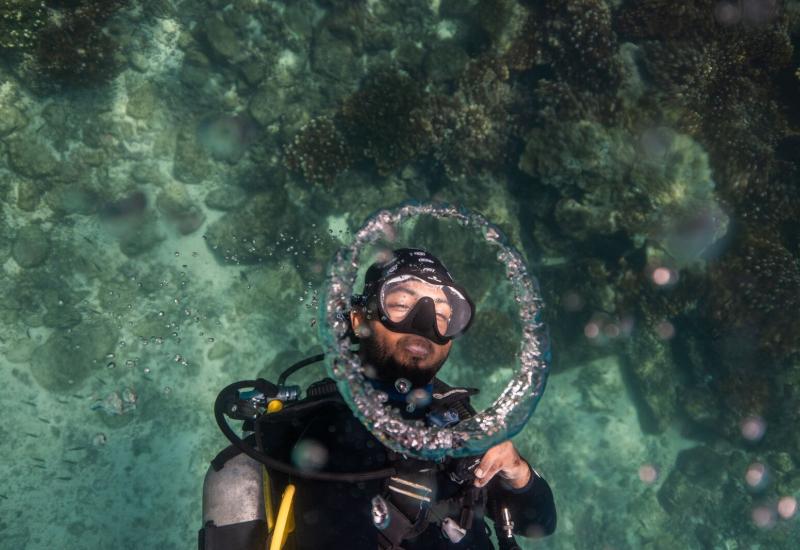The Galapagos Islands: The Greatest Show on Earth
It’s 3PM, the hot, bright equatorial sun still remains high in its descending arch to the western horizon. The wind is calm and the sea smooth as our rigid bottom inflatable (aka RBI or panga) driver Alex, idles the short distance from the Galapagos Aggressor II (GAII) to our entry point, a cove near Punta Vicente Roca, on the northeast corner of Isla Isabela.
Armed in seven mils of black neoprene from head to toe, the five divers in our panga are beginning to sweat uncomfortably under the blazing sun. Richard, our divemaster, is also completely covered in black rubber and senses our discomfort.
“Divers’ get ready!” he hurries, and we don our masks, insert our regulator mouth pieces and check our photo kits one last time.
It’s an oxymoron really, having to apply thick rubber suits for a dive at latitude 0.0536 south; yes, one-half-of-a-degree south of the equator! But we are diving the Galapagos Islands, a climate paradox due to geography, which straddle the earth’s latitudinal centerline in the eastern Pacific Ocean, 1000Km from South America.
Logically, it’s fair to reason that waters bathing the Galapagos archipelago should be bathtub-warm. Yet, due to its unique global placement, the Galapagos Islands are washed by three major and four minor oceanic currents, which at times converge, diverge, mix and layer, resulting in continuous water temperature contradictions. And this occurs throughout the islands; which is why we were ensconced in protective apparel at Punta Vicente Roca.
“On the count of three!” Richard alerts, and, in unison, we roll into a warm, murky brine at the end of his count.
The oxymoron continues; at the surface, this site has little current. Seawater pools around the cove and warms considerably in the tropical sun. The result is a local micro-bloom of plankton in the nutrient rich surface water, which contrasts with the cool water below an ever-present thermocline by as much as 12C.
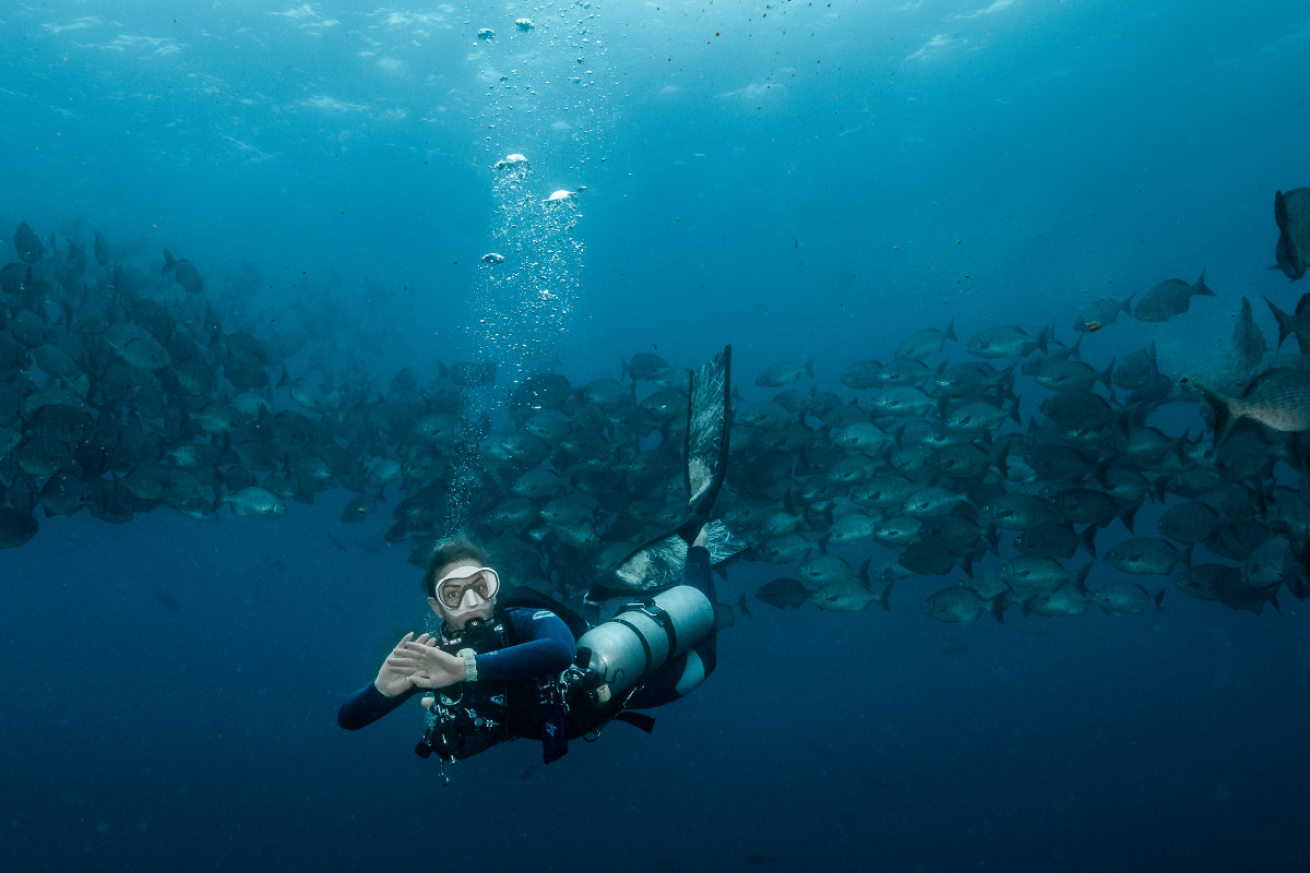
Mark B. HatterDiving the incredible Galapagos Islands.
Collectively we settle, piercing the murky soup at 15m, to a deep green, very clear, ethereal world. At the shimmering transition between warm and cool, the temperature instantly drops from 26C to 20C, with the visibility going from one to +33m!
We glide the slope downward, adjusting buoyancy, past spectacularly colored tapestries of sea fans, toward the white sandy bottom at nearly 35m. In the gloaming a pair of juvenile Galapagos sea lions, ubiquitous on most dives in the Galapagos, rocket past us from behind. Then, shooting upward, they barrel-roll through our exhaust trails to the surface, their playful drive-by apparently complete. Now, three meters above the sandy floor, the water temperature has cooled to 17C, challenging our seven-mils, in the otherworldly twilight.
Suddenly, Richard bangs his tank with a metal clapper, snapping me from whiney thoughts about the cold. He signals our group to look toward the deep. In the distance, a pair of mola mola materialize, sliding slowly toward our gob-smacked band of observers. It’s a super-rare appearance, especially after Richard had proclaimed before the dive that we would likely not see mola mola, because it was “too warm.”
No longer thinking about the chill, I check my camera, hold my bubble exhaust and push with a single thrust toward the lead fish, trying to look small and innocuous. While not a full-sized adult, this fish appears to span at least two meters between fin tips. I glide closer and the mola mola follows me with a large, curious eye. I am, apparently, not a threat, but also nothing of interest. The mola mola turns to the deep and slowly disappears with a gentle flutter of its giant dorsal and ventral fins. But only after I was able to click a single image!
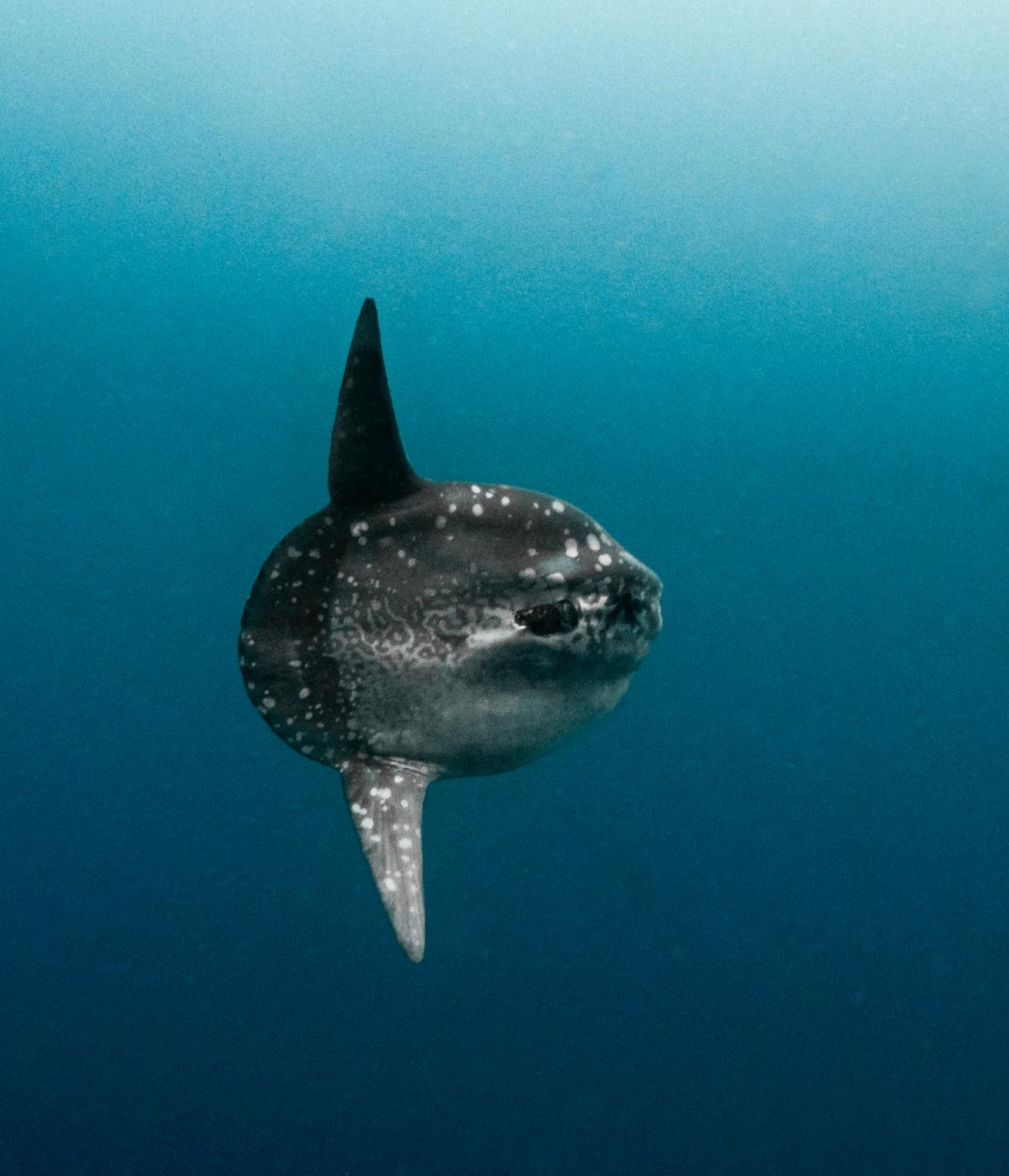
Mark B. HatterMola Mola
I turn back to the group where the wall meets the sandy plane and watch my fellow divers celebrate the uber-exceptional sighting with excited head bobs and fist pumps. In spite of Richard’s prediction, or, maybe because of Richard’s prediction, we had a close encounter with an animal I’ve never before witnessed in 40 years of diving!
Time is short and we move to a valley of soft corals, beyond the sandy plane, in search of elusive seahorses. Our good juju continues, Richard and one of our divers each find a cleverly camouflaged seahorse among the softies.
Excitement abounds in the now refreshingly cool deep-sea as we shoot our images and search for other exotics before our dive computers tick toward finality.
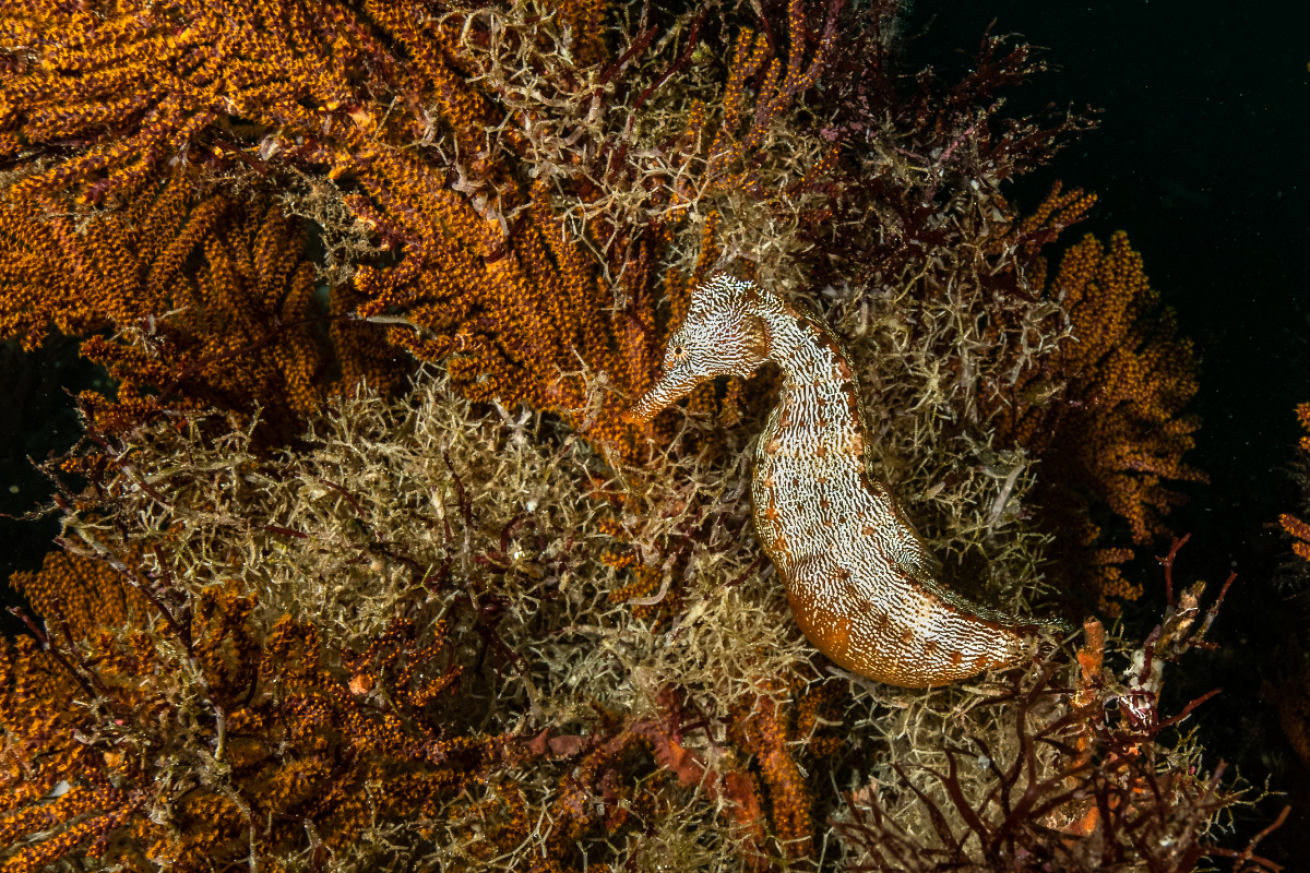
Mark B. HatterA skillfully disguised seahorse.
So it can go in the Galapagos Islands. A carnival of animal oddities and rarities, both on land and sea, which attracts divers from around the world. So unique are the fauna, one could almost envision an early, 20th century carney barker loquaciously extolling the exotica.
“Ladies and Gentlemen…Step right Up! Come inside and be incredulous! Feast your eyes on a one-ton fish with no fins and no tail! Or marvel at the schooling sharks whose heads are shaped like a coat hanger! Not impressed? How about a tortoise as big as a clown-car or a lizard that eats in the sea?”
Indeed, the Galapagos Islands may well be the “greatest show on earth.” Since the fall of 1825 when Charles Darwin, aboard the British brig HMS Beagle, set foot in the Galapagos, explorers have acclaimed the wonders of these magnificent islands. Having been called “a unique living museum and showcase of evolution” and, “a melting pot of marine species” by visiting naturalists, the Galapagos are a bucket list destination for many. Truly, it is this, which has brought me back to these remarkable islands for the 5th time in the last 15 years.
The Galapagos archipelago is comprised of 127 islands, islets and rocks set between latitudes 1.40 degrees North and 1.36 degrees South. Volcanic in origin, the islands are relatively young geologically, only some five million years old, and, in the case of Isla Isabela and Isla Fernandina, are still actively forming. Indeed, as the GAII steamed toward Darwin Island on the second evening of our voyage, Wolf Volcano on Isabela was clearly visible spewing smoke, ash and lava on its northern flank.
It’s the geographic location, isolation, and confluence of ocean currents, taking the Galapagos’ metaphorical “petri-dish of black volcanic rock,” which has resulted in the speciation of 14 different land animals found nowhere else in the world. These animals include the Galapagos penguin, the Galapagos tortoise, the marine iguana, the blue-footed booby, the Galapagos flightless cormorant, and the Galapagos hawk.
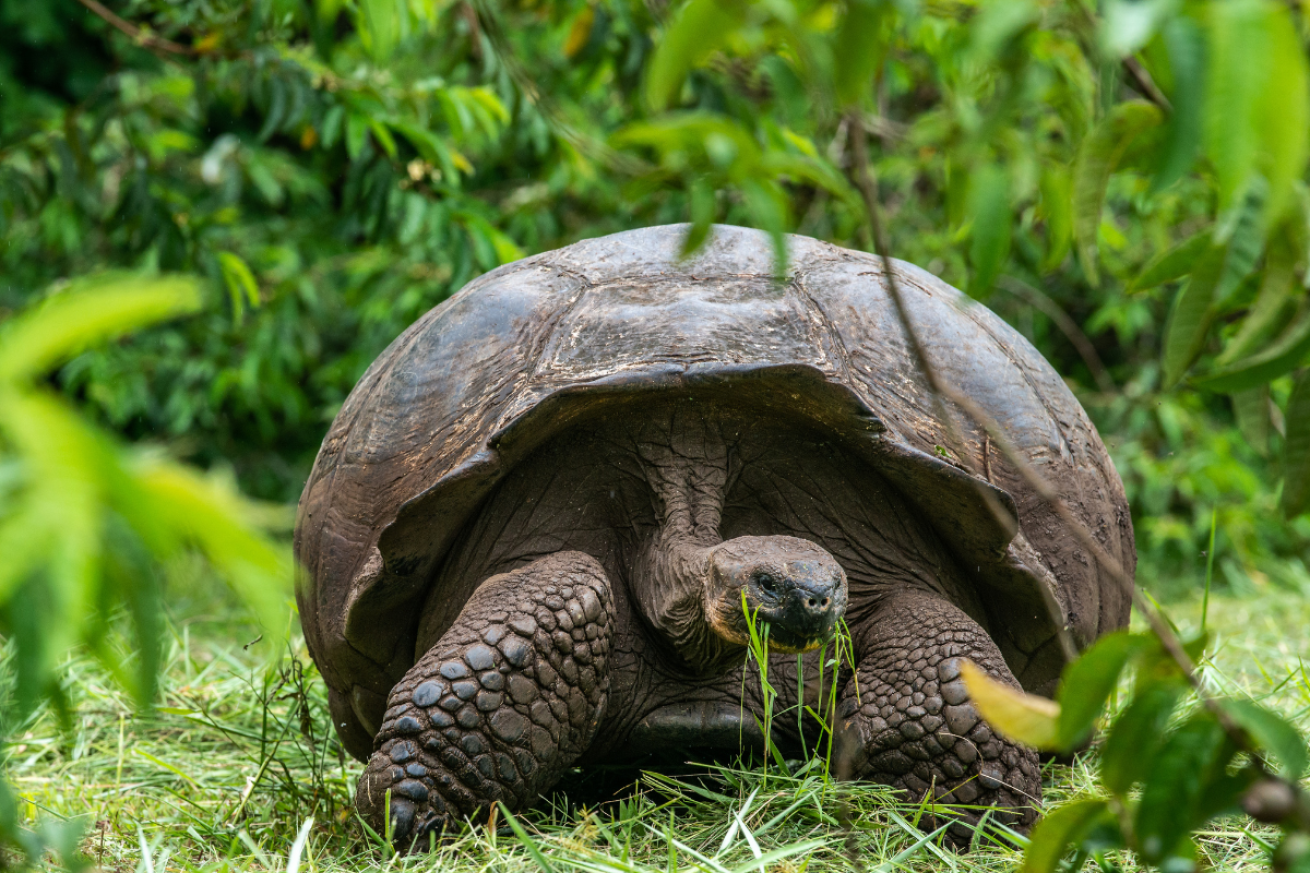
Mark B. HatterIsla Santa Cruz giant tortoise.
Oceanwise, speciation is not quite as unique. Many resident species, such as the scalloped hammerhead shark, Galapagos shark, eagle ray and green sea turtle are found elsewhere as ocean currents have brought circum-tropical and circum-temperate marine life to the islands more easily. As such, the only apparent endemic species I could find in research is the green sea urchin, which were wonderfully abundant at Roca Blanca.
The split personality of water temperatures, coupled with unique land creatures, and side-show-like marine animals, all on the same voyage, invites an action packed week for divers and underwater photographers. Where else can a diver find tropical long-nose butterflyfish one day and temperate loving mola mola on the next?
The northern islands of Wolf and Darwin were our first major destination on our week’s long voyage on the GAII. Located above the equator and washed by a relatively warm equatorial current (warm enough to support stoney corals), these islands are renown for schooling scalloped hammerhead sharks, eagle rays and the rare whale shark when currents are strong and unidirectional.
Oddly, during our visit, which coincided with the back of the full moon, when tides should have been the strongest, the current(s) seemed confused, often pushing one way on the surface and the opposite direction down deep. As a result, the schooling sharks were a no-show. We did, however, witness many single shark drive-bys during our dives and were able to fully explore the reef surrounding Darwin’s Columns (formerly Darwin’s Arch) and Landslide Reef at Wolf.
The mild, conflicted currents also gave us an opportunity to shoot other locations (the Cave at Wolf Island) and lesser acknowledged “side-show circus performers” on the reefs, including curious schools of barber fish and sedate green sea turtles when our focus would have been otherwise directed (literally and figuratively) to the sharks.
While the Galapagos’ circus-center-ring performers were on hiatus in the north, the Islands’ side-show performers of the south picked up the slack. At Cape Douglas on Isla Fernandina, the marine iguanas were sun-fueled early and entered the water at 10AM to feed, giving our divers on the GAII a unique opportunity to observe yet another oxymoron of the archipelago; the lizard that eats in the sea.
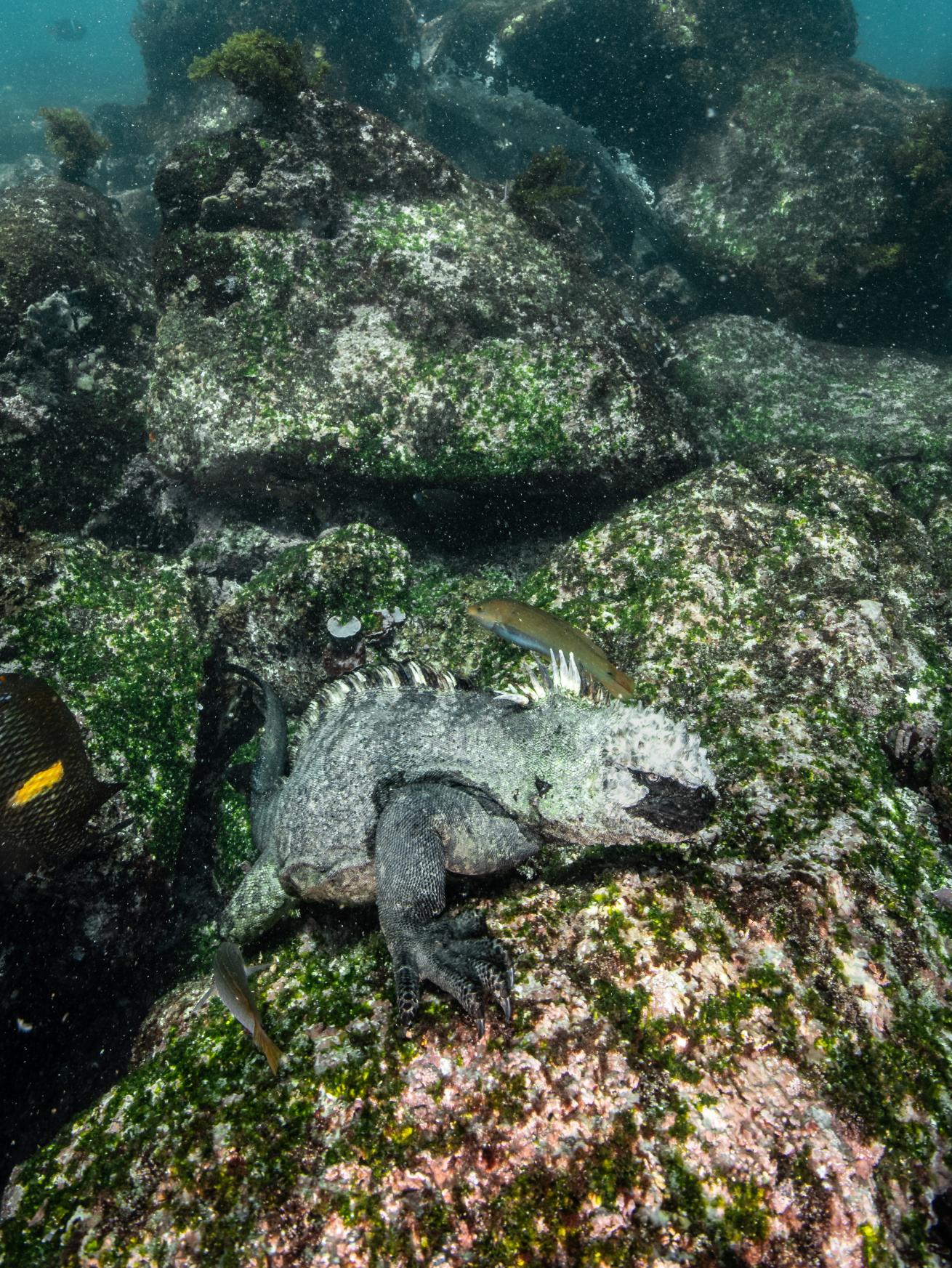
Mark B. HatterCape Douglas marine iguana
By the hundreds, if not thousands, the charcoal-colored reptiles perch on the back volcanic rocks, if not each other, at Cape Douglas near oceans’ edge. There, they warm themselves sufficiently before venturing in to the cool Pacific to briefly feed on marine algae. Our carnival barker would have been pleased, as we indeed marveled, incredulous, at this behavioral oddity.
Further along our voyage in the south we encountered the omnipresent Galapagos Sea Lions, whose playful antics drive a photographer mad. Like Whirling Dervish, the endemic pinnipeds’ fluidity challenged my shooting on every level. While the juveniles are the most curious, young females will often join in, eventually eliciting a response from the harem’s dominate male.
As if to say, “alright, enough is enough!” the large male will run interference between the divers and the females blowing a “warning” exhaust trail of bubbles from his nostrils.
One afternoon at a relatively innocuous rock named Cowley, we encountered “the mother of all” fish schools. The site is famous for its massive school of black striped salema. Thousands, if not millions of salema shift shape endlessly from the surface to sea floor at Cowley. If it were not for the torch of our divemaster or the flicker of a strobe flash from my diving mates, I surely would have lost my way as the salema turned day to night at 20m.
No trip to the Galapagos can be considered complete without a land safari or two to observe more of Charles Darwin’s natural selection superstars. The GAII gave us two land excursions, plus a coastline cruise to find more animals endemic to Galapagos. At Isla Bartolome, we climb the peak (made famous in the Russell Crowe film, Master and Commander: The Far Side Of The World) where a Galapagos hawk, perched on a high rock, and a lava lizard, cooling its toes on a low rock, showcased a majestic overlook of the GAII in the passage below. At Pinnacle Rock we found blue-footed booby, Galapagos penguin and the Galapagos flightless cormorant, allowing image capture of yet more Galapagos “A-listers.”

Mark B. HatterGalapagos Aggressor II
On our last afternoon, after the attentive GAII staff had washed our dive kits, we traveled up-country to a farm on Isla Santa Cruz where we observed the final act of the circus, the world’s largest tortoise, in the wild. Our imaginary carnival barker would not have been exaggerating for the estimated 80 year old tortoise would have rivaled the size of a small clown car!
As I look back on the destinations I’ve explored over the years, I’m not surprised that the Galapagos has captured my time and interest several times over. The Galapagos Islands are indeed a circus of the odd, ridiculous and grandiose. And like the circus with requisite side shows, it draws the curious, like a moth to a flame. Which is why I’m already planning my sixth trip back to see, the greatest show on earth.
When to Go The Galapagos Islands can be visited year around as the change between summer and winter months is minimal on the equator. Check with your Aggressor trip planner while assessing the best time to see certain species with a higher degree of regularity based on the month of the year.
Getting There All flights to the Galapagos Islands originate from either Quito or Guayaquil in Ecuador. Plan on arriving in Ecuador the day before trip departure. Direct flights to the Islands from either Quito or Guayaquil are available from two airlines, several time each day.
Choosing An Adventure Itinerary Visit www.aggressor.com
Other Information The travel planners at Aggressor will apprise you of latest travel requirements/restrictions based on most current COVID-19 conditions.




